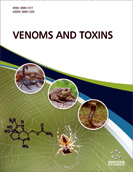
Abstract
Background: Cholera is a life-threatening secretory diarrheal disease caused by Vibrio cholera bacterium. On the contrary, local and specific use of cholera toxin (CT) at a low concentration can cause controlled fluid secretion. In the study, we explored the secretory action of CT in the intestine of rats with acute renal failure (ARF).
Methods: Closed intestinal loop experiments were performed in ARF rats treated with CT. Secreted fluid and serum were analyzed for various solutes and electrolytes. The presence of K+, Na+, Cl-, urea and creatinine were monitored. Histopathology analysis was carried out to evaluate the effect of CT in liver, kidney, and intestinal tissues.
Results: A reduction in the absorption of water and electrolytes was observed over time and a secretory response started to appear within hours of CT treatment. The fluid secretory response with entrapped electrolytes was profound in ARF rats. Histopathological analysis of CT exposed tissues revealed that apart from the tissue damage produced by acute renal failure, no CT induced cellular changes occurred.
Conclusion: CT can be used as a secretagogue to induce fluid and electrolyte secretion in ARF rats. However, effective measures should be taken to avoid CT induced acidosis.
Keywords: Cholera toxin, acute renal failure, secretagogue, electrolytes, intestinal fluid, intestinal loop.
Graphical Abstract
[http://dx.doi.org/10.1007/BF00502580] [PMID: 6771659]
[http://dx.doi.org/10.1172/JCI109051] [PMID: 659596]
[http://dx.doi.org/10.1126/science.2549637] [PMID: 2549637]
[http://dx.doi.org/10.3181/00379727-140-36444] [PMID: 5033104]
[http://dx.doi.org/10.1016/0016-5085(95)90005-5] [PMID: 7806061]
[http://dx.doi.org/10.1093/infdis/116.3.303] [PMID: 5940329]
[http://dx.doi.org/10.1371/journal.pntd.0002293] [PMID: 23826402]
[http://dx.doi.org/10.1006/jmbi.1995.0456] [PMID: 7658473]
[http://dx.doi.org/10.1128/mr.56.4.622-647.1992] [PMID: 1480112]
[http://dx.doi.org/10.1152/advan.00035.2004] [PMID: 15905150]
[http://dx.doi.org/10.4155/fmc.12.1] [PMID: 22393940]
[http://dx.doi.org/10.1038/nrgastro.2015.111] [PMID: 26122478]
[http://dx.doi.org/10.1099/jmm.0.024752-0] [PMID: 21212148]
[http://dx.doi.org/10.1038/s41598-017-10693-4] [PMID: 28860665]
[http://dx.doi.org/10.1136/gut.33.9.1174] [PMID: 1427368]
[http://dx.doi.org/10.1136/gutjnl-2013-306236] [PMID: 25209656]
[http://dx.doi.org/10.1016/0092-8674(91)90446-6] [PMID: 1716180]
[http://dx.doi.org/10.1053/j.gastro.2003.11.005] [PMID: 14762788]
[http://dx.doi.org/10.1056/NEJM198612183152506] [PMID: 3785323]
[http://dx.doi.org/10.1681/ASN.V651463] [PMID: 8589324]
 12
12 1
1


